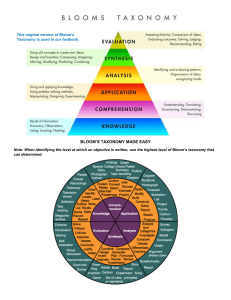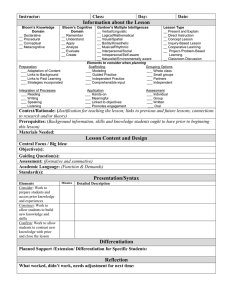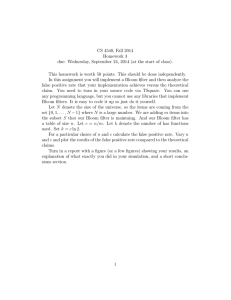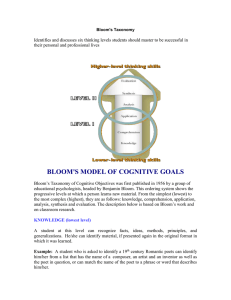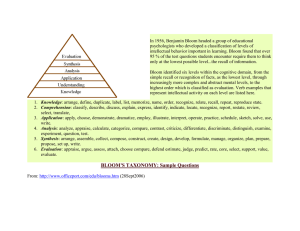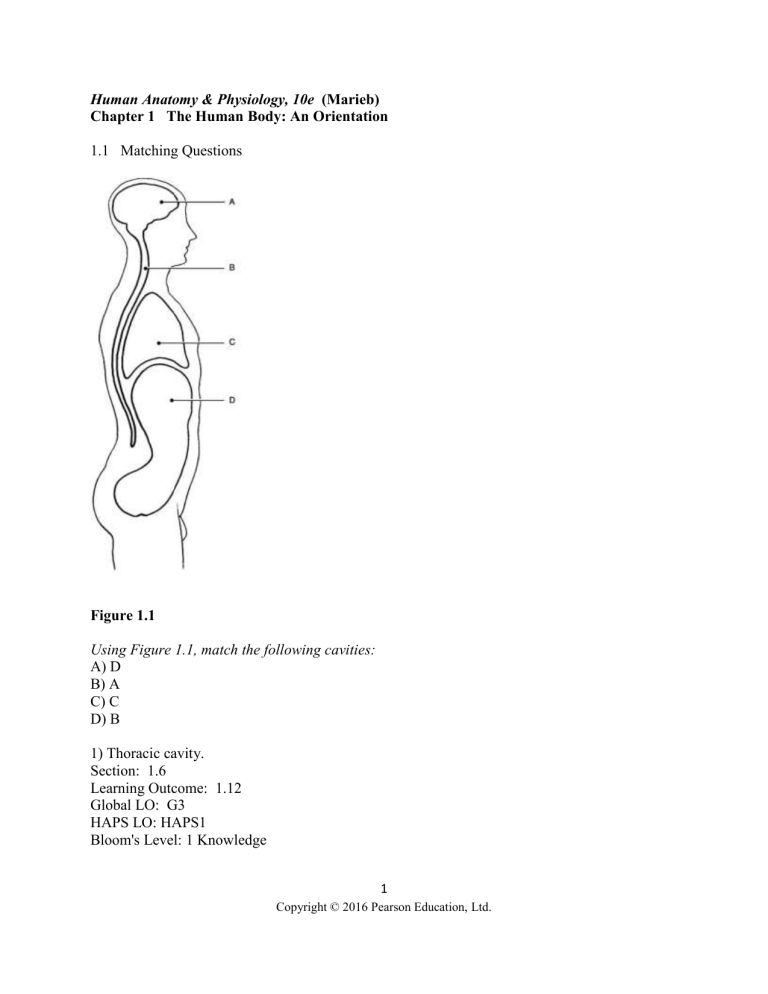
Human Anatomy & Physiology, 10e (Marieb) Chapter 1 The Human Body: An Orientation 1.1 Matching Questions Figure 1.1 Using Figure 1.1, match the following cavities: A) D B) A C) C D) B 1) Thoracic cavity. Section: 1.6 Learning Outcome: 1.12 Global LO: G3 HAPS LO: HAPS1 Bloom's Level: 1 Knowledge 1 Copyright © 2016 Pearson Education, Ltd. 2) Cranial cavity. Section: 1.6 Learning Outcome: 1.12 Global LO: G3 HAPS LO: HAPS1 Bloom's Level: 1 Knowledge 3) Abdominal cavity. Section: 1.6 Learning Outcome: 1.12 Global LO: G3 HAPS LO: HAPS1 Bloom's Level: 1 Knowledge 4) Vertebral cavity. Section: 1.6 Learning Outcome: 1.12 Global LO: G3 HAPS LO: HAPS1 Bloom's Level: 1 Knowledge Answers: 1) C 2) B 3) A 4) D 2 Copyright © 2016 Pearson Education, Ltd. Figure 1.2 Using Figure 1.2, match the following descriptions to the most appropriate letter on the diagram: A) E B) A C) B D) D E) C 5) Information about body temperature is sent through afferent pathways to the brain. Section: 1.4 Learning Outcome: 1.7, 1.8 Global LO: G2, G3 HAPS LO: HAPS2, HAPS3 Bloom's Level: 3 Application 6) Free nerve endings in the skin detect changes in skin temperature (getting colder). Section: 1.4 Learning Outcome: 1.7, 1.8 Global LO: G2, G3 HAPS LO: HAPS2, HAPS3 Bloom's Level: 3 Application 7) Appropriate response information is sent through efferent pathways. Section: 1.4 Learning Outcome: 1.7, 1.8 Global LO: G2, G3 HAPS LO: HAPS2, HAPS3 Bloom's Level: 3 Application 3 Copyright © 2016 Pearson Education, Ltd. 8) A change in the temperature of the external environment (getting colder). Section: 1.4 Learning Outcome: 1.7, 1.8 Global LO: G2, G3 HAPS LO: HAPS2, HAPS3 Bloom's Level: 3 Application 9) Skeletal muscles respond with shivering reflex which provides heat to return the body's temperature to a homeostatic balance or "ideal" value. Section: 1.4 Learning Outcome: 1.7, 1.8 Global LO: G2, G3 HAPS LO: HAPS2, HAPS3 Bloom's Level: 3 Application Answers: 5) E 6) C 7) D 8) B 9) A 4 Copyright © 2016 Pearson Education, Ltd. Match the following systems to their functions: A) Muscular B) Skeletal C) Integumentary D) Nervous 10) Provides the force to move bones about their joints. Section: 1.2 Learning Outcome: 1.4 Global LO: G2, G7 HAPS LO: HAPS2, HAPS5 Bloom's Level: 2 Comprehension 11) Responds to environmental changes by transmitting electrical impulses. Section: 1.2 Learning Outcome: 1.4 Global LO: G2, G7 HAPS LO: HAPS2, HAPS5 Bloom's Level: 2 Comprehension 12) Provides a ridged framework to support the body and stores minerals. Section: 1.2 Learning Outcome: 1.4 Global LO: G2, G7 HAPS LO: HAPS2, HAPS5 Bloom's Level: 2 Comprehension 13) Prevents water loss, entry of germs into the body and synthesizes vitamin D. Section: 1.2 Learning Outcome: 1.4 Global LO: G2, G7 HAPS LO: HAPS2, HAPS5 Bloom's Level: 2 Comprehension Answers: 10) A 11) D 12) B 13) C 5 Copyright © 2016 Pearson Education, Ltd. Match the following systems to their functions: A) Lymphatic B) Endocrine C) Immune D) Cardiovascular 14) Controls the body with chemical molecules called hormones. Section: 1.2 Learning Outcome: 1.4 Global LO: G2, G7 HAPS LO: HAPS2, HAPS5 Bloom's Level: 2 Comprehension 15) Delivers oxygen and nutrients to the tissues. Section: 1.2 Learning Outcome: 1.4 Global LO: G2, G7 HAPS LO: HAPS2, HAPS5 Bloom's Level: 2 Comprehension 16) Produces antibodies that attach to foreign substances. Section: 1.2 Learning Outcome: 1.4 Global LO: G2, G7 HAPS LO: HAPS2, HAPS5 Bloom's Level: 2 Comprehension 17) Removes and filters excess fluid from tissues. Section: 1.2 Learning Outcome: 1.4 Global LO: G2, G7 HAPS LO: HAPS2, HAPS5 Bloom's Level: 2 Comprehension Answers: 14) B 15) D 16) C 17) A 6 Copyright © 2016 Pearson Education, Ltd. Match the following examples of feedback mechanisms: A) Negative feedback B) Positive feedback 18) Used for changes in blood glucose levels. Section: 1.4 Learning Outcome: 1.7, 1.8 Global LO: G2, G3 HAPS LO: HAPS2, HAPS3 Bloom's Level: 2 Comprehension 19) Used for changes in blood pressure. Section: 1.4 Learning Outcome: 1.7, 1.8 Global LO: G2, G3 HAPS LO: HAPS2, HAPS3 Bloom's Level: 2 Comprehension 20) Used for blood clotting. Section: 1.4 Learning Outcome: 1.7, 1.8 Global LO: G2, G3 HAPS LO: HAPS2, HAPS3 Bloom's Level: 2 Comprehension 21) Used for childbirth. Section: 1.4 Learning Outcome: 1.7, 1.8 Global LO: G2, G3 HAPS LO: HAPS2, HAPS3 Bloom's Level: 2 Comprehension Answers: 18) A 19) A 20) B 21) B 7 Copyright © 2016 Pearson Education, Ltd. Match the following systems and organs: A) Respiratory B) Endocrine C) Digestive D) Urinary E) Cardiovascular 22) Arteries, veins, heart. Section: 1.2 Learning Outcome: 1.4 Global LO: G2, G7 HAPS LO: HAPS2, HAPS5 Bloom's Level: 2 Comprehension 23) Trachea, bronchi, alveoli. Section: 1.2 Learning Outcome: 1.4 Global LO: G2, G7 HAPS LO: HAPS2, HAPS5 Bloom's Level: 2 Comprehension 24) Adrenal glands, pancreas, pituitary. Section: 1.2 Learning Outcome: 1.4 Global LO: G2, G7 HAPS LO: HAPS2, HAPS5 Bloom's Level: 2 Comprehension 25) Esophagus, large intestine, rectum. Section: 1.2 Learning Outcome: 1.4 Global LO: G2, G7 HAPS LO: HAPS2, HAPS5 Bloom's Level: 2 Comprehension 26) Kidneys, bladder, ureters. Section: 1.2 Learning Outcome: 1.4 Global LO: G2, G7 HAPS LO: HAPS2, HAPS5 Bloom's Level: 2 Comprehension Answers: 22) E 23) A 24) B 25) C 26) D 8 Copyright © 2016 Pearson Education, Ltd. Match the following cavities and organs: A) Abdominopelvic B) Cranial C) Thoracic 27) Stomach. Section: 1.6 Learning Outcome: 1.12 Global LO: G7 HAPS LO: HAPS1 Bloom's Level: 1 Knowledge 28) Heart. Section: 1.6 Learning Outcome: 1.12 Global LO: G7 HAPS LO: HAPS1 Bloom's Level: 1 Knowledge 29) Uterus. Section: 1.6 Learning Outcome: 1.12 Global LO: G7 HAPS LO: HAPS1 Bloom's Level: 1 Knowledge 30) Brain. Section: 1.6 Learning Outcome: 1.12 Global LO: G7 HAPS LO: HAPS1 Bloom's Level: 1 Knowledge 31) Lungs. Section: 1.6 Learning Outcome: 1.12 Global LO: G7 HAPS LO: HAPS1 Bloom's Level: 1 Knowledge Answers: 27) A 28) C 29) A 30) B 31) C 9 Copyright © 2016 Pearson Education, Ltd. Match the following regional terms and common terms: A) Brachial B) Gluteal C) Thoracic D) Patellar E) Cephalic 32) Arm. Section: 1.5 Learning Outcome: 1.11 Global LO: G7 HAPS LO: HAPS1 Bloom's Level: 1 Knowledge 33) Buttock. Section: 1.5 Learning Outcome: 1.11 Global LO: G7 HAPS LO: HAPS1 Bloom's Level: 1 Knowledge 34) Head. Section: 1.5 Learning Outcome: 1.11 Global LO: G7 HAPS LO: HAPS1 Bloom's Level: 1 Knowledge 35) Knee (anterior aspect). Section: 1.5 Learning Outcome: 1.11 Global LO: G7 HAPS LO: HAPS1 Bloom's Level: 1 Knowledge 36) Chest. Section: 1.5 Learning Outcome: 1.11 Global LO: G7 HAPS LO: HAPS1 Bloom's Level: 1 Knowledge Answers: 32) A 33) B 34) E 35) D 36) C 10 Copyright © 2016 Pearson Education, Ltd. Match the regional/directional terms and examples: A) Proximal B) Anterior C) Distal D) Medial E) Lateral 37) The bridge of the nose is ________ to the left eye. Section: 1.5 Learning Outcome: 1.11 Global LO: G7 HAPS LO: HAPS1 Bloom's Level: 2 Comprehension 38) The upper arm is ________ to the forearm. Section: 1.5 Learning Outcome: 1.11 Global LO: G7 HAPS LO: HAPS1 Bloom's Level: 2 Comprehension 39) The lungs are ________ to the heart. Section: 1.5 Learning Outcome: 1.11 Global LO: G7 HAPS LO: HAPS1 Bloom's Level: 2 Comprehension 40) The fingers are ________ to the wrist. Section: 1.5 Learning Outcome: 1.11 Global LO: G7 HAPS LO: HAPS1 Bloom's Level: 2 Comprehension 41) The stomach is ________ to the spine. Section: 1.5 Learning Outcome: 1.11 Global LO: G7 HAPS LO: HAPS1 Bloom's Level: 2 Comprehension Answers: 37) D 38) A 39) E 40) C 41) B 11 Copyright © 2016 Pearson Education, Ltd. 1.2 True/False Questions 1) Positive feedback mechanisms tend to enhance the original stimulus so that the response is accelerated. Answer: TRUE Section: 1.4 Learning Outcome: 1.8 Global LO: G7 HAPS LO: HAPS1, HAPS3 Bloom's Level: 3 Application 2) Digital Subtraction Angiography (DSA) imaging is most useful in discovering obstructed blood supplies in organs and tissues. Answer: TRUE Section: 1.5 Learning Outcome: 1.8 Global LO: G9 HAPS LO: HAPS6, HAPS7 Bloom's Level: 3 Application 3) The elbow is proximal to the shoulder. Answer: FALSE Section: 1.5 Learning Outcome: 1.11 Global LO: G7 HAPS LO: HAPS1 Bloom's Level: 2 Comprehension 4) The part of the serous membrane that lines the peritoneal cavity wall is called visceral peritoneum. Answer: FALSE Section: 1.6 Learning Outcome: 1.12 Global LO: G7 HAPS LO: HAPS1 Bloom's Level: 1 Knowledge 5) A major function of serous membranes is to decrease friction. Answer: TRUE Section: 1.6 Learning Outcome: 1.12 Global LO: G7 HAPS LO: HAPS2 Bloom's Level: 2 Comprehension 12 Copyright © 2016 Pearson Education, Ltd. 6) The right hypochondriac region contains the majority of the stomach. Answer: FALSE Section: 1.6 Learning Outcome: 1.12 Global LO: G7 HAPS LO: HAPS1 Bloom's Level: 1 Knowledge 7) Lungs carry out an excretory function. Answer: TRUE Section: 1.2 Learning Outcome: 1.4 Global LO: G2, G7 HAPS LO: HAPS2 Bloom's Level: 2 Comprehension 8) Embryology concerns the structural changes that occur in an individual from conception through old age. Answer: FALSE Section: 1.1 Learning Outcome: 1.1 Global LO: G7 HAPS LO: HAPS1 Bloom's Level: 1 Knowledge 9) A tissue consists of groups of similar cells that have a common function. Answer: TRUE Section: 1.2 Learning Outcome: 1.3 Global LO: G7 HAPS LO: HAPS1 Bloom's Level: 1 Knowledge 10) It is important for any organism to maintain its boundaries, so that its internal environment remains distinct from the external environment surrounding it. Answer: TRUE Section: 1.3 Learning Outcome: 1.5 Global LO: G7 HAPS LO: HAPS2 Bloom's Level: 1 Knowledge 13 Copyright © 2016 Pearson Education, Ltd. 11) Without some sort of negative feedback mechanism, it would be impossible to keep our body chemistry in balance. Answer: TRUE Section: 1.4 Learning Outcome: 1.8 Global LO: G7 HAPS LO: HAPS1, HAPS3 Bloom's Level: 3 Application 12) Responsiveness or irritability is the ability to sense changes in the environment and then respond to them. Answer: TRUE Section: 1.3 Learning Outcome: 1.5 Global LO: G7 HAPS LO: HAPS1 Bloom's Level: 1 Knowledge 13) The epigastric region is superior to the umbilical region. Answer: TRUE Section: 1.6 Learning Outcome: 1.13 Global LO: G7 HAPS LO: HAPS1 Bloom's Level: 2 Comprehension 14 Copyright © 2016 Pearson Education, Ltd. 1.3 Multiple Choice Questions 1) Histology would be best defined as a study of ________. A) tissues B) the gross structures of the body C) cell chemistry D) cells Answer: A Section: 1.1 Learning Outcome: 1.1 Global LO: G7 HAPS LO: HAPS1 Bloom's Level: 1 Knowledge 2) The study of large body structures, visible to the naked eye, such as the heart is called ________ anatomy. A) microscopic B) gross C) systemic D) developmental Answer: B Section: 1.1 Learning Outcome: 1.1 Global LO: G7 HAPS LO: HAPS1 Bloom's Level: 1 Knowledge 3) Generally what is the result of the negative feedback process? A) to keep the body's blood sugar level high B) to control body movement C) to regulate excretion via the kidneys D) to maintain homeostasis Answer: D Section: 1.4 Learning Outcome: 1.8 Global LO: G7 HAPS LO: HAPS1, HAPS3 Bloom's Level: 3 Application 4) The coxal joint is most likely found in ________ region of the body. A) hip B) hand C) foot D) groin Answer: A 15 Copyright © 2016 Pearson Education, Ltd. Section: 1.5 Learning Outcome: 1.11 Global LO: G7 HAPS LO: HAPS1 Bloom's Level: 3 Application 5) A structure that is composed of two or more tissue types that work together to perform specific functions for the body is a(n) ________. A) complex tissue B) organ C) complex cell D) organ system Answer: B Section: 1.2 Learning Outcome: 1.3 Global LO: G7 HAPS LO: HAPS1, HAPS2 Bloom's Level: 1 Knowledge 6) A good example of a positive feedback mechanism would be ________. A) enhancement of labor contractions B) body temperature regulation C) blood calcium level regulation D) regulating glucose levels in the blood Answer: A Section: 1.4 Learning Outcome: 1.8 Global LO: G7 HAPS LO: HAPS1, HAPS3 Bloom's Level: 3 Application 7) Which of the following organs or structures would be found in the left iliac region? A) liver B) appendix C) intestines D) stomach Answer: C Section: 1.6 Learning Outcome: 1.13 Global LO: G7 HAPS LO: HAPS2 Bloom's Level: 2 Comprehension 8) The parietal pleura would represent a serous membrane ________. A) lining the abdominal cavity 16 Copyright © 2016 Pearson Education, Ltd. B) covering the heart C) covering individual lungs D) lining the thoracic cavity Answer: D Section: 1.6 Learning Outcome: 1.12 Global LO: G7 HAPS LO: HAPS2 Bloom's Level: 2 Comprehension 9) Which one of the following systems responds fastest to environmental stimuli? A) immune B) lymphatic C) muscular D) nervous Answer: D Section: 1.2 Learning Outcome: 1.4 Global LO: G2, G7 HAPS LO: HAPS2, HAPS5 Bloom's Level: 2 Comprehension 10) Choose the anatomical topic and definition that is not correctly matched. A) Cytology: study of the structures in a particular region. B) Microscopic anatomy: study of structures too small to be seen by the naked eye. C) Embryology: study of the changes in an individual from conception to birth. D) Gross anatomy: study of structures visible to the eye. Answer: A Section: 1.1 Learning Outcome: 1.1 Global LO: G7 HAPS LO: HAPS1 Bloom's Level: 1 Knowledge 11) Homeostasis is the condition in which the body maintains ________. A) a dynamic state within an unlimited range, depending on circumstances B) a relatively stable internal environment, within limits C) the lowest possible energy usage D) a static state with no deviation from preset points Answer: B Section: 1.4 Learning Outcome: 1.7 Global LO: G7 HAPS LO: HAPS1, HAPS3 Bloom's Level: 1 Knowledge 17 Copyright © 2016 Pearson Education, Ltd. 12) In which body cavities are the lungs located? A) pleural, dorsal, and abdominal B) pleural, ventral, and thoracic C) pericardial, ventral, and thoracic D) mediastinal, thoracic, and ventral Answer: B Section: 1.6 Learning Outcome: 1.12 Global LO: G7 HAPS LO: HAPS2 Bloom's Level: 1 Knowledge 13) Place the following in correct sequence from simplest to most complex: 1. molecules 2. atoms 3. tissues 4. cells 5. organs A) 1-2-4-3-5 B) 2-1-4-3-5 C) 1-2-3-4-5 D) 2-1-3-4-5 Answer: B Section: 1.2 Learning Outcome: 1.3 Global LO: G7 HAPS LO: HAPS1, HAPS2 Bloom's Level: 1 Knowledge 14) Which of the following imaging devices would best localize a tumor in a person's brain? A) PET B) DSA C) MRI D) X ray Answer: C Section: 1.5 Learning Outcome: Global LO: G9 HAPS LO: HAPS6, HAPS7 Bloom's Level: 3 Application 15) Which of these is not part of the dorsal cavity? A) spinal cord B) cranial cavity 18 Copyright © 2016 Pearson Education, Ltd. C) thoracic cavity D) vertebral cavity Answer: C Section: 1.6 Learning Outcome: 1.12 Global LO: G7 HAPS LO: HAPS2 Bloom's Level: 1 Knowledge 16) In which quadrant of the abdominopelvic cavity is the stomach located? A) left upper quadrant B) right upper quadrant C) right lower quadrant D) left lower quadrant Answer: A Section: 1.6 Learning Outcome: 1.13 Global LO: G7 HAPS LO: HAPS2 Bloom's Level: 1 Knowledge 17) Which of the following statements is the most correct regarding homeostatic imbalance? A) It is considered the cause of most diseases. B) Positive feedback mechanisms are overwhelmed. C) Negative feedback mechanisms are functioning normally. D) The internal environment is becoming more stable. Answer: A Section: 1.4 Learning Outcome: 1.8 Global LO: G7 HAPS LO: HAPS1, HAPS3 Bloom's Level: 2 Comprehension 18) The term pollex refers to the ________. A) fingers B) thumb C) great toe D) calf Answer: B Section: 1.5 Learning Outcome: 1.11 Global LO: G7 HAPS LO: HAPS1 Bloom's Level: 1 Knowledge 19 Copyright © 2016 Pearson Education, Ltd. 19) The dorsal body cavity is the site of which of the following? A) liver B) brain C) intestines D) lungs Answer: B Section: 1.6 Learning Outcome: 1.12 Global LO: G7 HAPS LO: HAPS1 Bloom's Level: 1 Knowledge 20) Select the most correct statement. A) Organ systems can be composed of cells or tissues, but not both. B) The immune system is closely associated with the lymphatic system. C) Organ systems operate independently of each other to maintain life. D) The endocrine system is not a true structural organ system. Answer: B Section: 1.2 Learning Outcome: 1.3 Global LO: G7 HAPS LO: HAPS1, HAPS2 Bloom's Level: 2 Comprehension 21) One of the functional characteristics of life is excitability or responsiveness. This refers to ________. A) the necessity for all organisms to reproduce B) sensing changes in the environment and then reacting or responding to them C) indigestible food residues stimulating the excretory system D) the nervous system causing all living things to sometimes experience anger Answer: B Section: 1.3 Learning Outcome: 1.5 Global LO: G7 HAPS LO: HAPS2 Bloom's Level: 2 Comprehension 22) Which of the following are survival needs of the body? A) nutrients, water, growth, and reproduction B) nutrients, water, atmospheric pressure, and oxygen C) nutrients, water, movement, and reproduction D) water, atmospheric pressure, growth, and movement Answer: B Section: 1.3 Learning Outcome: 1.5 20 Copyright © 2016 Pearson Education, Ltd. Global LO: G7 HAPS LO: HAPS2 Bloom's Level: 2 Comprehension 23) What is a vertical section through the body, dividing it into left and right, called? A) frontal B) transverse C) regional D) sagittal Answer: D Section: 1.5 Learning Outcome: 1.11 Global LO: G7 HAPS LO: HAPS1 Bloom's Level: 1 Knowledge 24) What is a vertical section through the body, dividing it into anterior and posterior regions called? A) median B) sagittal C) frontal D) transverse Answer: C Section: 1.5 Learning Outcome: 1.11 Global LO: G7 HAPS LO: HAPS1 Bloom's Level: 1 Knowledge 25) The body cavities that protect the nervous system are located in the ________ cavity. A) ventral B) cranial C) dorsal D) vertebral E) thoracic Answer: C Section: 1.6 Learning Outcome: 1.12 Global LO: G7 HAPS LO: HAPS1 Bloom's Level: 1 Knowledge 26) Which of the following describes the operation of the heart and blood vessels? A) systemic anatomy B) cardiovascular anatomy 21 Copyright © 2016 Pearson Education, Ltd. C) cardiovascular physiology D) systemic physiology Answer: C Section: 1.1 Learning Outcome: 1.1 Global LO: G7 HAPS LO: HAPS1 Bloom's Level: 3 Application 27) It is wise to study anatomy alongside with physiology because ________. A) it makes for more efficient use of students' and teachers' time B) physiology is only explainable in terms of the underlying anatomy C) anatomy and physiology are practically the same thing D) to understand anatomy requires complete understanding of physiology Answer: B Section: 1.1 Learning Outcome: 1.2 Global LO: G2, G7 HAPS LO: HAPS2 Bloom's Level: 4 Analysis 28) The study of anatomy and physiology assumes and describes a healthy body. Select the description below that does NOT explain why this approach is useful. A) Study of a healthy body is less intimidating and more familiar new students. B) A healthy body provides a common standard to compare to. C) A healthy body establishes what "normal" is. D) Study of a healthy body provides a foundation for a more complete understanding of all human bodies. Answer: A Section: 1.1 Learning Outcome: 1.2 Global LO: G2, G7 HAPS LO: HAPS2 Bloom's Level: 6 Evaluation 29) One of the descriptions below is from the perspective of anatomical study, the rest are from a physiological perspective. Select the description below that comes from an anatomical perspective. A) The extremely thin tissue (simple squamous epithelium) of the lungs allows for the quick diffusion of respiratory gases into and out of the body. B) The direction of blood flow through the heart is directed by one way valves. C) The cell-to-cell connections between heart (cardiac) muscle cells are strong. They hold the tissue together for a life time of forceful contractions. D) The innermost lining of the lungs is composed primarily of a thin tissue called simple squamous epithelium. 22 Copyright © 2016 Pearson Education, Ltd. Answer: D Section: 1.1 Learning Outcome: 1.1 Global LO: G2, G7 HAPS LO: HAPS1, HAPS2 Bloom's Level: 4 Analysis 30) One of the descriptions below is from the perspective of physiological study, the rest are from an anatomical perspective. Select the description below that comes from physiological perspective. A) The pancreas lies deep to the stomach within the abdominal cavity. B) The skull is formed by 22 facial and cranial bones. C) The contraction of smooth muscle in blood vessels (vasoconstriction) can reduce the flow of blood through the vessel. D) The chambers of the heart and blood vessels leading to and from the heart are separated by valves composed of fibrous connective tissue. Answer: C Section: 1.1 Learning Outcome: 1.1 Global LO: G2, G7 HAPS LO: HAPS1, HAPS2 Bloom's Level: 4 Analysis 31) Which of the following is the best explanation for why cells are considered the smallest units of living things. A) Cells are the simplest structure to fit all of the characteristic necessary to be considered alive. B) Cells have the ability to reproduce identical copies of themselves in a process called mitosis. C) Cells are highly ordered and complex. D) Cells cannot be seen with the naked eye and are considered microscopic. Answer: A Section: 1.2, 1.3 Learning Outcome: 1.3, 1.5 Global LO: G2 HAPS LO: HAPS1, HAPS2 Bloom's Level: 4 Analysis 32) Prevention of water loss is a necessary function for life that would best fit in the category of ________. A) metabolism B) responsiveness C) maintaining boundaries D) excretion Answer: C Section: 1.3 Learning Outcome: 1.5 23 Copyright © 2016 Pearson Education, Ltd. Global LO: G2 HAPS LO: HAPS1, HAPS2 Bloom's Level: 3 Application 33) Anabolic reactions are chemical reactions of the body that build things, make them bigger or more complex. Catabolic reactions break things down making them smaller or less complex. If the rate of anabolic reaction in the body is much faster than the rate of catabolic reactions which of the following necessary life function will be accomplished? A) digestion B) responsiveness C) growth D) movement Answer: C Section: 1.3 Learning Outcome: 1.5 Global LO: G2 HAPS LO: HAPS1, HAPS2 Bloom's Level: 4 Analysis 34) Anatomical position is important because ________. A) it allows a common point of reference for body position to help communicate anatomical relationships B) it provides the greatest circulation to the extremities C) it allows diagrams within textbooks to display a greater surface area of the body with one simple diagram D) it is the position most comfortable to hospital patients Answer: A Section: 1.5 Learning Outcome: 1.10a Global LO: G2, G7 HAPS LO: HAPS2, HAPS6 Bloom's Level: 4 Analysis 35) Positive feedback differs from negative feedback because ________. A) positive feedback is critical to health while negative feedback serves only to alert us to potential health threats B) positive feedback is generally beneficial while negative feedback is typically harmful C) positive feedback tends to enhance the triggering stimulus while negative feedback tends to return the body to a homeostatic balance or "ideal" level D) positive feedback provides moment-to-moment wellbeing while negative feedback causes a cascade effect Answer: C Section: 1.4 Learning Outcome: 1.8 Global LO: G2, G7 24 Copyright © 2016 Pearson Education, Ltd. HAPS LO: HAPS1, HAPS3 Bloom's Level: 3 Application 36) When a baby suckles at its mother's breast the stimulus at the breast is sent to the mother's brain (a region called the hypothalamus). The brain responds by releasing hormones to stimulate the production and the ejection of milk from the breast. This helps the newborn to receive nourishment and encourages more suckling. This example is best described as a ________. A) negative feedback B) necessary life function C) loss of homeostasis D) positive feedback Answer: D Section: 1.4 Learning Outcome: 1.8 Global LO: G2, G7 HAPS LO: HAPS1, HAPS3 Bloom's Level: 3 Application 37) Some of the nerve endings in the skin are sensitive to changes in temperature. They are part of a negative feedback mechanism regulating body temperature. These nerve endings represent a(n) ________ in the negative feedback mechanism. A) receptor B) control center C) homeostatic balance or "ideal" value D) effector Answer: A Section: 1.4 Learning Outcome: 1.8 Global LO: G2, G7 HAPS LO: HAPS1, HAPS3 Bloom's Level: 3 Application 38) You are asked to take a person's heart rate at the popliteal pulse point. You will look for this pulse ________. A) on the palmar side of the hand B) in the distal end of the lower leg C) on the posterior side of the knee D) at the posterior side of the wrist Answer: C Section: 1.5 Learning Outcome: 1.11 Global LO: G2, G7 HAPS LO: HAPS1, HAPS6 Bloom's Level: 3 Application 25 Copyright © 2016 Pearson Education, Ltd. 39) You are told to take an axillary temperature on a small child. You will place the thermometer ________. A) in the armpit B) in the rectum C) under the tongue D) on the forehead Answer: A Section: 1.5 Learning Outcome: 1.11 Global LO: G2, G7 HAPS LO: HAPS1, HAPS6 Bloom's Level: 3 Application 40) You are asked to draw blood from the median cubital vein. You will search for this vein in the ________. A) lateral side of the foot B) proximal arm C) anterior side of the elbow D) hand Answer: C Section: 1.5 Learning Outcome: 1.11 Global LO: G2, G7 HAPS LO: HAPS1, HAPS6 Bloom's Level: 3 Application 41) The thoracic cavity contains the ________. It is found ________ to the vertebral cavity. A) stomach and liver: superficial B) heart and lungs: anterior C) digestive viscera: inferior D) kidneys and spleen: deep Answer: B Section: 1.5 Learning Outcome: 1.11 Global LO: G2 HAPS LO: HAPS1 Bloom's Level: 3 Application 26 Copyright © 2016 Pearson Education, Ltd. 1.4 Short Answer Questions 1) Similar cells that have a common function are called ________. Answer: tissues Section: 1.2 Learning Outcome: 1.3 Global LO: G7 HAPS LO: HAPS1 Bloom's Level: 1 Knowledge 2) What does the "principle of complementarity of structures and function" mean? Answer: What a structure can do depends on its specific form, or "structure determines function." Section: 1.1 Learning Outcome: 1.2 Global LO: G7 HAPS LO: HAPS2 Bloom's Level: 4 Analysis 3) The term that describes the back of the elbow is ________. Answer: olecranal Section: 1.5 Learning Outcome: 1.11 Global LO: G7 HAPS LO: HAPS1 Bloom's Level: 1 Knowledge 4) The term that describes the neck region is ________. Answer: cervical Section: 1.5 Learning Outcome: 1.11 Global LO: G7 HAPS LO: HAPS1 Bloom's Level: 1 Knowledge 5) The heart is ________ to the lungs. Answer: medial Section: 1.5 Learning Outcome: 1.11 Global LO: G7 HAPS LO: HAPS1 Bloom's Level: 1 Knowledge 6) ________ is explained by chemical and physical principles and is concerned with the function of specific organs or organic systems. 27 Copyright © 2016 Pearson Education, Ltd. Answer: Physiology Section: 1.1 Learning Outcome: 1.1 Global LO: G7 HAPS LO: HAPS1 Bloom's Level: 2 Comprehension 7) What is a dynamic equilibrium of your internal environment termed? Answer: homeostasis Section: 1.4 Learning Outcome: 1.8 Global LO: G7 HAPS LO: HAPS3 Bloom's Level: 1 Knowledge 8) Which cavity contains the bladder, some reproductive organs, and the rectum? Answer: pelvic Section: 1.6 Learning Outcome: 1.12 Global LO: G7 HAPS LO: HAPS1 Bloom's Level: 1 Knowledge 9) What is the serous membrane that covers the intestines called? Answer: visceral peritoneum Section: 1.6 Learning Outcome: 1.12 Global LO: G7 HAPS LO: HAPS1 Bloom's Level: 1 Knowledge 10) What broad term covers all chemical reactions that occur within the body cells? Answer: metabolism Section: 1.3 Learning Outcome: 1.6 Global LO: G7 HAPS LO: HAPS1 Bloom's Level: 1 Knowledge 11) What is the function of the serous membranes? Answer: They act to reduce friction and allow the organs to slide across cavity walls. Section: 1.6 Learning Outcome: 1.12 Global LO: G7 HAPS LO: HAPS2 28 Copyright © 2016 Pearson Education, Ltd. Bloom's Level: 2 Comprehension 12) Can lungs carry out excretory functions? Explain your answer. Answer: Yes, carbon dioxide is a metabolic waste the lungs excrete. Section: 1.2, 1.3 Learning Outcome: 1.4 Global LO: G7 HAPS LO: HAPS5 Bloom's Level: 3 Application 13) The ability to sense changes in the environment and respond to them is called ________. Answer: responsiveness or excitability Section: 1.3 Learning Outcome: 1.5 Global LO: G7 HAPS LO: HAPS2 Bloom's Level: 2 Comprehension 14) Why must a normal body temperature be maintained in order for chemical reactions to be continued at life-sustaining rates? Answer: If body temperature is too low, chemical reactions slow and eventually stop. If body temperature is too high, chemical reactions speed up and body proteins lose their normal shape, resulting in loss of function. Section: 1.3 Learning Outcome: 1.5 Global LO: G7 HAPS LO: HAPS2 Bloom's Level: 3 Application 15) What is the pathway between the receptor and the control center in the reflex pathway called? Answer: afferent pathway Section: 1.4 Learning Outcome: 1.8 Global LO: G7 HAPS LO: HAPS2 Bloom's Level: 1 Knowledge 16) What type of homeostatic feedback reflex is the withdrawal reflex? Answer: negative Section: 1.4 Learning Outcome: 1.8 Global LO: G7 HAPS LO: HAPS2 Bloom's Level: 3 Application 29 Copyright © 2016 Pearson Education, Ltd. 17) Why are the abdominopelvic cavity organs the most vulnerable to blunt deceleration in an automobile accident with seat belts? Answer: The walls of the abdominal cavity are formed only by trunk muscles and are not reinforced by bone. The pelvic organs receive a somewhat greater degree of protection from the bony pelvis. Section: 1.6 Learning Outcome: 1.12 Global LO: G7 HAPS LO: HAPS2 Bloom's Level: 4 Analysis 18) What is the action of all of the negative feedback mechanisms of the body? Answer: They prevent sudden severe changes within the body. Section: 1.4 Learning Outcome: 1.8 Global LO: G7 HAPS LO: HAPS2 Bloom's Level: 2 Comprehension 19) Which feedback mechanism causes the variable to deviate further and further from its original value or range? Answer: positive feedback Section: 1.4 Learning Outcome: 1.8 Global LO: G7 HAPS LO: HAPS2 Bloom's Level: 3 Application 20) What can happen when the usual negative feedback mechanisms are overwhelmed and destructive positive feedback mechanisms take over? Answer: Homeostatic imbalances increase our risk for illness and produce the changes we associate with aging. Section: 1.4 Learning Outcome: 1.8 Global LO: G2 HAPS LO: HAPS4 Bloom's Level: 4 Analysis 21) Which body system would be most affected by a lower than normal atmospheric pressure? Answer: respiratory system Section: 1.2 Learning Outcome: 1.4 Global LO: G2 HAPS LO: HAPS4 30 Copyright © 2016 Pearson Education, Ltd. Bloom's Level: 4 Analysis 22) Describe the overlap in function between the cardiovascular system and respiratory system. In other words, describe how they work together. Answer: The blood is provided a consistent supply of oxygen from the lungs while the circulatory system delivers carbon dioxide which will be removed from the body by the respiratory system. Section: 1.2 Learning Outcome: 1.4 Global LO: G2, G7 HAPS LO: HAPS2, HAPS5 Bloom's Level: 5 Synthesis 23) Describe the overlap in function between the muscular system and skeletal system. In other words, describe how they work together. Answer: The skeleton provides the ridged frame work (levers) for muscles to attach to. Muscles provide the force to move the bones about the joints. Section: 1.2 Learning Outcome: 1.4 Global LO: G2, G7 HAPS LO: HAPS2, HAPS5 Bloom's Level: 5 Synthesis 24) The integumentary system helps to maintain a boundary between the internal and external environment. Give an example of something that is prevented entry to the body and an example of something prevented from escaping the body by the integumentary system. Answer: The integument prevents entry of pathogens (germs, viruses, bacteria) OR harmful chemicals. The integumentary system prevents water (body fluid) loss. Section: 1.2 Learning Outcome: 1.4 Global LO: G2, G7 HAPS LO: HAPS2, HAPS5 Bloom's Level: 5 Synthesis 25) Describe the opposing ways that the muscular system and integumentary system act as effectors in the regulation of body temperature. Answer: The integument cools the body through sweat while the muscular system warms the body by shivering. Section: 1.2 Learning Outcome: 1.4 Global LO: G2, G7 HAPS LO: HAPS2, HAPS5 Bloom's Level: 5 Synthesis 31 Copyright © 2016 Pearson Education, Ltd. 1.5 Clinical Questions 1) A small family was traveling in its van and had a minor accident. The children in the back seats were wearing lap belts, but still sustained numerous bruises about the abdomen, and had some internal organ injuries. Why is this area more vulnerable to damage than others? Answer: The abdominal organs are the least protected in the body because they are not surrounded by a bony covering such as the ribs, pelvis, or cranium. Section: 1.6 Learning Outcome: 1.12 Global LO: G7 HAPS LO: HAPS2 Bloom's Level: 4 Analysis 2) Steve was injured in a football accident. X-ray examination showed a fracture underlying his left brachial deformity. What part of his body was injured? Answer: His left upper arm Section: 1.5 Learning Outcome: 1.11 Global LO: G7 HAPS LO: HAPS1 Bloom's Level: 3 Application 3) The nurse charted: "Patient has an open wound located on lateral aspect of leg." Describe where the wound is located. Answer: The wound is located on the outer side of the leg, the peroneal or fibular area. Section: 1.5 Learning Outcome: 1.11 Global LO: G7 HAPS LO: HAPS1 Bloom's Level: 3 Application 32 Copyright © 2016 Pearson Education, Ltd.

